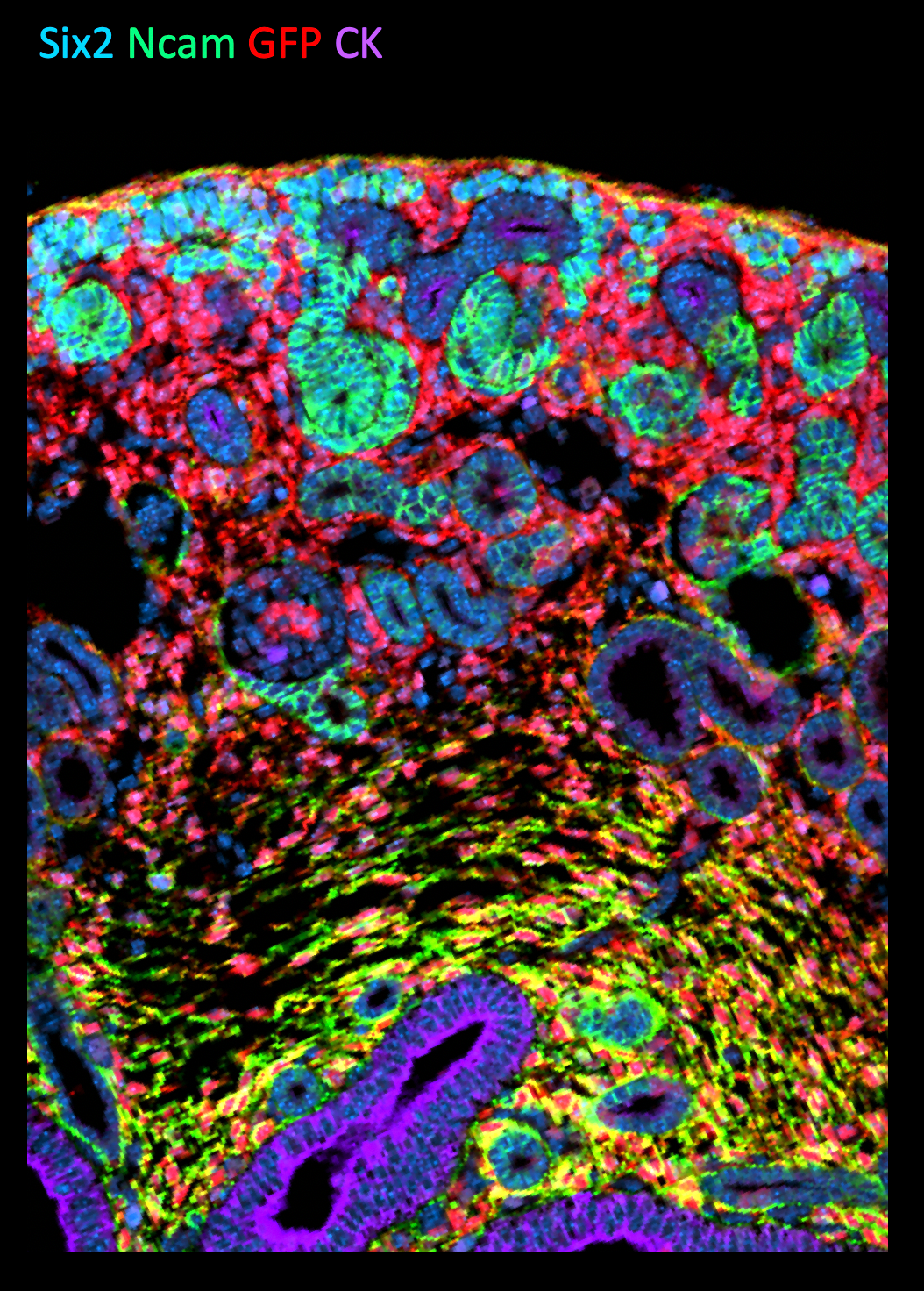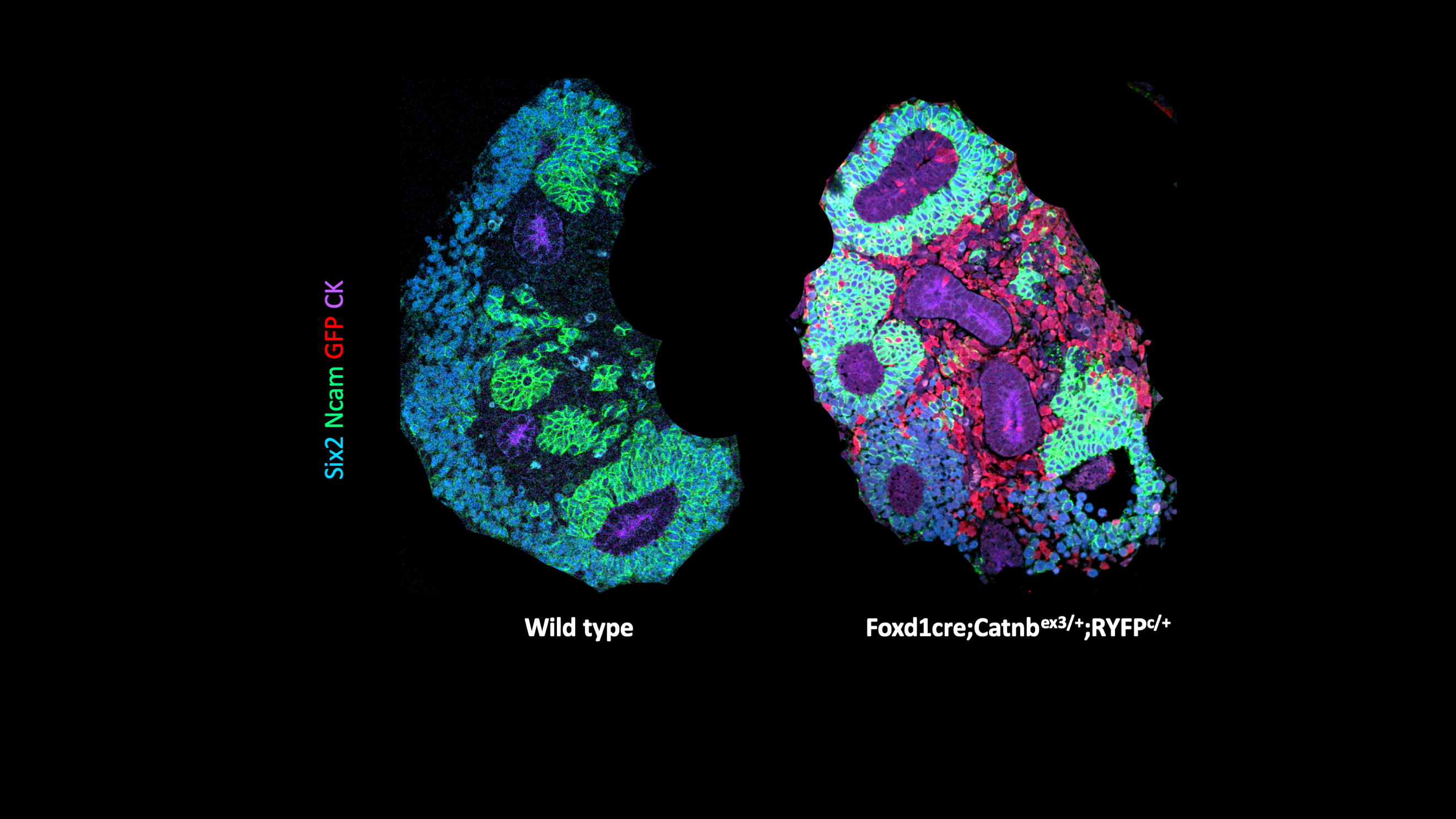Kidney Cancer



Posted March 26, 2021
Keri A. Drake, M.D., University of Texas, Southwestern Medical Center at Dallas

Dr. Keri Drake

Figure 1. The structure of a normally developing kidney is shown here, with NPCs (Six2+; blue), developing tubules (Ncam+, green) and stromal cells (Foxd1cre; RosaYFPc/+ lineage traced cells; red).
The kidney is a highly complex organ that arises from three cell populations established early in development – nephron progenitor cells (NPCs), ureteric bud (UB), and stromal progenitor cells, as shown in Figure 1. During normal development, NPCs (shown in blue) divide and differentiate into an immature tubule (shown in green) that will become a nephron, the functional unit of the kidney. There is a fine balance between the rate at which NPCs divide to create more cells and the number that differentiate to generate nephrons, which is regulated by signals from the surrounding stroma (shown in red). Normally, nephron development is complete during late gestation in utero, with no NPCs remaining after birth. However, 1 in every 10,000 children in Europe and North America are diagnosed with Wilms Tumor (WT) [1], where NPCs abnormally persist and continue dividing, resulting in this specialized type of kidney cancer primarily affecting children in the first 5 years of life.
WT arises from renal precursor cells and maintains features of the embryonic kidney, consisting of blastema/NPCs, epithelium, and stromal cells. While stromal components play important roles in supporting normal tissue development and have been linked to tumor formation, progression, and metastasis in many cancers [2], little is known about the role of the stroma in WT. A significant proportion of WTs harbor activating mutations in the β-catenin gene, which is a crucial transcription factor in Wingless-Int (WNT) signaling. Mutations render the β-catenin protein resistant to degradation, resulting in unregulated gene activity in about 15% of tumors, while approximately 50% of the tumors show evidence of this upregulated activity even without these specific mutations. While the β-catenin/WNT pathway has been investigated in kidney cancer, its role in regulating the malignant transformation of the stromal lineage is not well understood. The Kidney Cancer Research Program (KCRP) funded Dr. Keri Drake with a Fiscal Year 2018 Physician Research Award to characterize kidney formation responses in mice with stromal β-catenin activation.
Dr. Drake and colleagues identified human WT samples with β-catenin-activating mutations in NPC and stromal components. They used mouse models to activate the genetic mutation of β-catenin in the stromal and nephron progenitor lineages and characterize the effects on the developing kidneys. In both lineages, β-catenin activation severely disturbed nephrogenesis and contributed to the expression of genes in NPCs and stromal cells that would normally be found in the developing renal interstitium. When activated in the nephron progenitor lineage, β-catenin resulted in the premature loss of NPCs. This finding directly contrasted the expanded NPC population identified when β-catenin is activated in the stromal lineage (Figure 2).
 Figure 2. Activation of β-catenin in the developing renal stroma (Foxd1cre;Catnbex3/+;RosaYFPc/+) resulted in abnormal NPCs (Six2+ cells; blue) that failed to differentiate, similar to nephrogenic rests/blastema found in WTs.
Figure 2. Activation of β-catenin in the developing renal stroma (Foxd1cre;Catnbex3/+;RosaYFPc/+) resulted in abnormal NPCs (Six2+ cells; blue) that failed to differentiate, similar to nephrogenic rests/blastema found in WTs.
Taken together, these findings build upon the understanding of how β-catenin functions in kidney development and may contribute to WT. While Dr. Drake focused on the lineage-specific effects in stromal and nephron progenitor cells, further investigation of β-catenin activation is necessary to fully understand its role in Wilms tumorigenesis. With the support of the KCRP, Dr. Drake and the research team at UT Southwestern identified a strong link between stromal activation of β-catenin and WT pathogenesis, with ultimate goal of better understanding how targeting such pathways could lead to the development of novel therapeutic treatments for WT.
References:
- Wilms tumor: MedlinePlus Genetics. (2020, August 18). Retrieved March 08, 2021, from https://medlineplus.gov/genetics/condition/wilms-tumor/#frequency
- Valkenburg KC, de Groot AE, and Pienta KJ. 2018. Targeting the tumour stroma to improve cancer therapy. Nature Reviews Clinical Oncology 15(6):366-381.
Publication:
Drake KA, Chaney CP, Das A, Roy P, Kwartler CS, Rakheja D, Carroll TJ. 2020. Stromal β-catenin activation impacts nephron progenitor differentiation in the developing kidney and may contribute to Wilms tumor. Development 147(21):dev189597. doi: 10.1242/dev.189597. PMID: 32541007; PMCID: PMC7406317.Link:
Public and Technical Abstract: Defining the Role of Beta-Catenin Activation in Wilms TumorLast updated Friday, March 7, 2025














